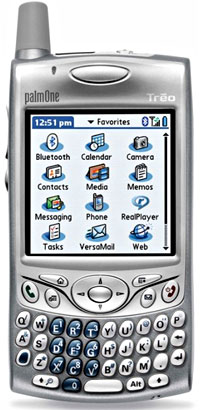 As you know, we *heart* nice, new shiny gadgets and we love to sit on the (sometimes uncomfortable) cutting edge of technology.
As you know, we *heart* nice, new shiny gadgets and we love to sit on the (sometimes uncomfortable) cutting edge of technology.
So when it comes to smartphones, we’re only going to be interested in strutting around with the very latest, gizmo-stuffed, state of the art model, right?
Wrong. In fact, my favourite phone remains the comparatively ancient Palm Treo 650 which, at nearly three years old, probably makes it the oldest piece of technology we’re still using!
So why have I gone backwards when there’s so many new, all-singing, all-dancing smartphones about?
The answer is simplicity.
The Palm platform may not be basking in the white heat of technology, but sometimes it’s more comfortable to hang out in the more temperate margins where things don’t get so sticky.
 With the Treo just about everything works.
With the Treo just about everything works.
Unlike every Windows Mobile device we’ve tried, it feels like a proper smartphone rather than a phone bolted on to a PDA (or vice versa).
Based on the mature (some may suggest over-ripe) Palm OS, the Treo provides an intuitive and stable interface, with the five way controller and tightly integrated software ensuring that the stylus stays docked in the silo for most everyday tasks.
When there’s a need to input some text, the Treo has one of the best small keyboards in the business, with its brightly illuminated QWERTY keypad perfect for short emails and text messages.
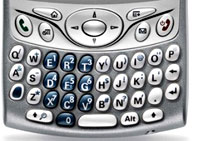 Moreover, the interface is fast and responsive and although Palm’s idea of multi-tasking is simply to close down whatever you’re doing and start up the next program (while remembering all the settings) it doesn’t suffer from the gradual slowdown to a crawl that constantly blighted our Windows experience.
Moreover, the interface is fast and responsive and although Palm’s idea of multi-tasking is simply to close down whatever you’re doing and start up the next program (while remembering all the settings) it doesn’t suffer from the gradual slowdown to a crawl that constantly blighted our Windows experience.
While there’s a good argument that Palm OS is in danger of becoming woefully outdated, it still does the job jus’ dandy and with the deft addition of a few third party programs, you can end up with a flexible device that can hold its own against everything else out there.
In part two, i’ll explain why I find the Palm interface and aesthetics to be some of the best in the business, but for those who love to peruse spec sheets, here’s the basics:
 Palm Treo 650
Palm Treo 650
wireless radio: GSM/GPRS/EDGE model: 850/900/1800/1900 MHz world phone. GPRS class 10B
processor: Intel™ PXA270 312 MHz processor
memory: 21MB user available stored non-volatile memory.
battery: Removable rechargeable lithium ion battery
talk time: Up to 6 hours talk time and up to 12.5 days standby time
operating system: Palm OS 5.4
size: 4.4 x 2.3 x 0.9 inches (11.3 x 5.9 x 2.3 cm)
weight: 6.3 oz. / 178 grams
display: Colour TFT touch-screen, 320 x 320 resolution, 16-bit colour (displays over 65,000 colours)
expansion: Supports SD, SDIO and MultiMediaCards
audio: RealPlayer included – requires SD memory card, sold separately
camera: VGA with 640×480 (0.3 megapixels) resolution and automatic light balancing, 2x zoom, captures video
 Palm have announced the successor to their hugely successful Palm OS-powered Treo 650 smartphone, the Treo 700p.
Palm have announced the successor to their hugely successful Palm OS-powered Treo 650 smartphone, the Treo 700p. Bundled with the phone is DataViz’ Documents To Go for reading and editing Microsoft Office files, a PDF viewer and an email client that works with Exchange Server 2003 via ActiveSync, plus POP and IMAP accounts.
Bundled with the phone is DataViz’ Documents To Go for reading and editing Microsoft Office files, a PDF viewer and an email client that works with Exchange Server 2003 via ActiveSync, plus POP and IMAP accounts.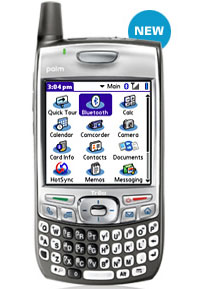 So much so that we’re even prepared to forgive the omission of Wi-Fi in the latest Treo (Palm in the US insist that EV-DO should be enough.)
So much so that we’re even prepared to forgive the omission of Wi-Fi in the latest Treo (Palm in the US insist that EV-DO should be enough.)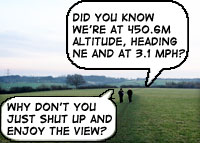 With the weather warming up and the great outdoors beckoning, here’s our selection of must-have gadgets for technology addicts heading off for a day strolling over heath and heather.
With the weather warming up and the great outdoors beckoning, here’s our selection of must-have gadgets for technology addicts heading off for a day strolling over heath and heather. Smartphone: Treo 650
Smartphone: Treo 650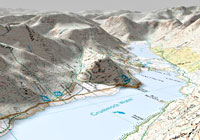 Where the chuffin’ ‘eck am I? GPS and Memory-Map
Where the chuffin’ ‘eck am I? GPS and Memory-Map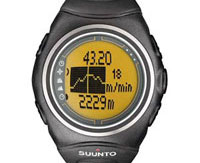
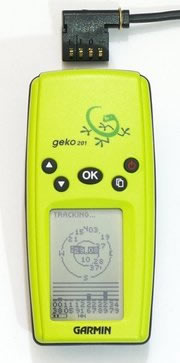 OpenStreetMap, an organisation that is using consumer technology to create copyright-free maps, is meeting this weekend (5-7 May) on the Isle of Wight – to map the whole Island and give the data away under a Creative Commons license.
OpenStreetMap, an organisation that is using consumer technology to create copyright-free maps, is meeting this weekend (5-7 May) on the Isle of Wight – to map the whole Island and give the data away under a Creative Commons license. Once the GPS data is combined with notes of road names taken via audio recordings or even notebooks (shock horror), accurate mapping data will be put into the OpenStreetMap system for all to share. Quite different to the huge cost that the Ordnance Survey (OS) is asking for similar data.
Once the GPS data is combined with notes of road names taken via audio recordings or even notebooks (shock horror), accurate mapping data will be put into the OpenStreetMap system for all to share. Quite different to the huge cost that the Ordnance Survey (OS) is asking for similar data. If you’re not submerged in this world, it may surprise you to find out that the United States actually gives its mapping data away for free. So through agents like Navtec, and Teleatlas, it ends up on applications like Yahoo & Google maps. Innovation like that isn’t possible in the UK as it falls at the first hurdle – that of huge expense.
If you’re not submerged in this world, it may surprise you to find out that the United States actually gives its mapping data away for free. So through agents like Navtec, and Teleatlas, it ends up on applications like Yahoo & Google maps. Innovation like that isn’t possible in the UK as it falls at the first hurdle – that of huge expense.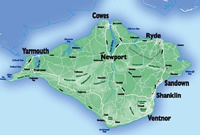 Organisation like the OS who do not let their data free will be be left clutching hold of something whose value has been severely diminished, if not zero’d.
Organisation like the OS who do not let their data free will be be left clutching hold of something whose value has been severely diminished, if not zero’d. Currently hovering betwixt prototype and retail status, Advance Tech Communications new Windows Mobile smartphone market looks hot! hot! hot!
Currently hovering betwixt prototype and retail status, Advance Tech Communications new Windows Mobile smartphone market looks hot! hot! hot!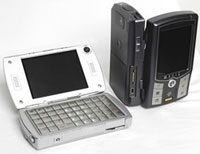 On board storage is taken care of courtesy of a generous 8GB hard disk, backed up by 512MB RAM and 512MB ROM, with a micro-SD expansion card slot.
On board storage is taken care of courtesy of a generous 8GB hard disk, backed up by 512MB RAM and 512MB ROM, with a micro-SD expansion card slot.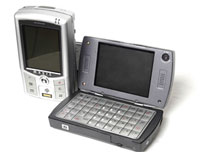 Instead, the company are proclaiming their new device to be a “laptop computer miniaturised to the size of a handheld device,” which perhaps isn’t the snappiest description they could have come up with.
Instead, the company are proclaiming their new device to be a “laptop computer miniaturised to the size of a handheld device,” which perhaps isn’t the snappiest description they could have come up with.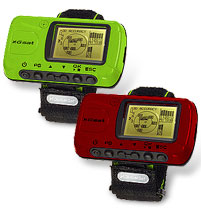 Jogging geeksters! Set your wallets to ‘buy’ as GlobalSat are set to release a wrist-type GPS Receiver aimed at sporty types who get their kicks from running around all over the place on foot, bike, board or ski.
Jogging geeksters! Set your wallets to ‘buy’ as GlobalSat are set to release a wrist-type GPS Receiver aimed at sporty types who get their kicks from running around all over the place on foot, bike, board or ski. Training projects and analysis come with the bundled Windows-compatible “professional self-training” package, but Apple users can stay at home because we couldn’t find any mention of Mac support.
Training projects and analysis come with the bundled Windows-compatible “professional self-training” package, but Apple users can stay at home because we couldn’t find any mention of Mac support.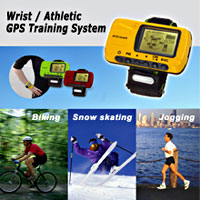 GPS Parameters
GPS Parameters  They’ve been bustier than Jock McHasty in a rush at i-mate, as the PDA/smartphone vendor releases another addition to their range, the i-mate PDA-N – the company’s first GPS PDA.
They’ve been bustier than Jock McHasty in a rush at i-mate, as the PDA/smartphone vendor releases another addition to their range, the i-mate PDA-N – the company’s first GPS PDA.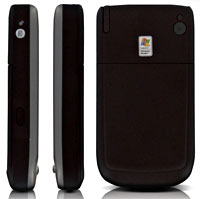 The front of the slim device is dominated by a 2.83″ 240×320 pixels transmissive TFT-LCD screen supporting 64k colours, with a row of four buttons and a joystick below.
The front of the slim device is dominated by a 2.83″ 240×320 pixels transmissive TFT-LCD screen supporting 64k colours, with a row of four buttons and a joystick below. According to I-mate, the PDA-N notches up a rated battery life of 5 hours in GPS mode and 8 hours playing a looped video.
According to I-mate, the PDA-N notches up a rated battery life of 5 hours in GPS mode and 8 hours playing a looped video. International men of mystery, jet setters, globe-trotters and drug smugglers might just be the niche group targeted by Carpoint’s world-spanning navigation system.
International men of mystery, jet setters, globe-trotters and drug smugglers might just be the niche group targeted by Carpoint’s world-spanning navigation system. Called the XRoad Paris (but, thankfully, no relation to the cash-rich, time-rich airhead of the same name) the device can guide users through nation after nation in a choice of seven languages.
Called the XRoad Paris (but, thankfully, no relation to the cash-rich, time-rich airhead of the same name) the device can guide users through nation after nation in a choice of seven languages.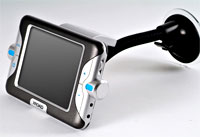 We assume the two chunky buttons each side of the screen are for making onscreen selections and scrolling through the map, but seeing as babelfish packed up mid-way through our attempt at a Korean translation, I guess we’ll never know.
We assume the two chunky buttons each side of the screen are for making onscreen selections and scrolling through the map, but seeing as babelfish packed up mid-way through our attempt at a Korean translation, I guess we’ll never know.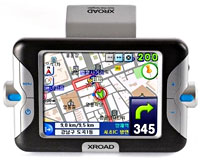 We can’t think of any over-riding reason why anyone would need a GPS unit stuffed full with half the world’s maps, but it’s certainly a well styled model and its encyclopedic knowledge of the world’s cities might come in useful in a pub quiz at the very least.
We can’t think of any over-riding reason why anyone would need a GPS unit stuffed full with half the world’s maps, but it’s certainly a well styled model and its encyclopedic knowledge of the world’s cities might come in useful in a pub quiz at the very least.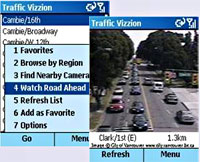 US firm Vizzion have announced the introduction of their innovative traffic-watching system “Traffic Vizzion” to eleven areas in the UK.
US firm Vizzion have announced the introduction of their innovative traffic-watching system “Traffic Vizzion” to eleven areas in the UK.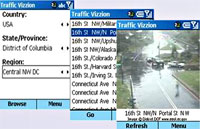 GPS users can also call up a “Find Nearby Cameras” function to list cameras close to their current location, and then select and view any camera from the list in the hope of finding the best way out of a jam.
GPS users can also call up a “Find Nearby Cameras” function to list cameras close to their current location, and then select and view any camera from the list in the hope of finding the best way out of a jam. Traffic Vizzion runs on Windows Mobile 2003 for Smartphones, and relies on a working Internet connection (e.g. GPRS), with a Bluetooth GPS device required for the added features.
Traffic Vizzion runs on Windows Mobile 2003 for Smartphones, and relies on a working Internet connection (e.g. GPRS), with a Bluetooth GPS device required for the added features. Cambridge outfit, HD Positions, have launched their ‘Boomerang Box’ device, a new low cost, high accuracy positioning system which locates vehicles and other valuable assets.
Cambridge outfit, HD Positions, have launched their ‘Boomerang Box’ device, a new low cost, high accuracy positioning system which locates vehicles and other valuable assets. The service works by HD Positions supplying the interface to Matrix, facilitating related Machine to Machine (M2M) services, including network connectivity, billing and support.
The service works by HD Positions supplying the interface to Matrix, facilitating related Machine to Machine (M2M) services, including network connectivity, billing and support. We tried to find a picture of the actual Boomerang Box, hopeful that it would be an amusing looking thing that would spice up this rather dull report, but there was nothing to be found on their Website.
We tried to find a picture of the actual Boomerang Box, hopeful that it would be an amusing looking thing that would spice up this rather dull report, but there was nothing to be found on their Website.